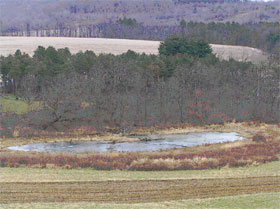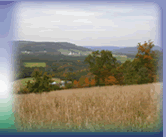CONSERVATION PRACTICE 23 ~
Wetland Restoration
Printable PDF File of Conservation Practice 23 (CP 23)
(Brochure will open in new window)
| Description: |
Guidelines: |
| CP 23, wetland restoration, is designed to restore the functions and values of a wetland ecosystem where land was previously devoted to agricultural use. This practice will benefit many wildlife species and protect Pennsylvania’s water resources. |
Wetlands restored under CP 23 must include a buffer to wetland ratio of up to 3:1. Wetland restoration projects through CREP can only occur on acres that have been converted to cropland, but have a historical presence of wetlands. Call your local NRCS office to see if your land is eligible for CREP’s CP 23. |
 |
What is a Wetland?
A wetland is not a pond. Wetlands are, "areas that are inundated or saturated by surface or groundwater at a frequency and duration sufficient to support, and that under normal circumstances do support, a prevalence of vegetation typically adapted for life in saturated soil conditions, including swamps, marshes, bogs and similar areas." – Section 404 of the Clean Water Act |
|
| |
|
| Eligibility: |
Conservation Practice Responsibilities: |
Any producer and/or landowner that has owned the offered acreage for one or more years is eligible.
CP 23 is only eligible on cropland with hydric soils.
|
CP 23 cannot use tall fescue and is limited to soils classed as PC (Prior Converted) hydric soils. Invasive/noxious weeds must be controlled. You can choose between a 10 or 15 year enrollment. |
| |
|
| Conservation Benefits: |
Additional Benefits: |
- Protection of permanent and seasonal wetlands.
- Filtration of nutrients, sediments, and pesticides.
- Restoration of wildlife habitat, particularly for waterfowl and wetland-dependent plants.
|
- Improved flood control and groundwater recharge.
- Financial savings and income on marginally productive land.
- Reduced wear and tear on equipment through avoidance of wet and swampy areas.
|
Possible Wildlife Attracted to CP 23 Wetland Restoration
For the wildlife enthusiast, the habitat established by CP 23 is utilized by a variety of animal and insect species throughout the seasons. Mammals and birds will use the wetland areas for feeding, drinking, cover, and nesting purposes. Many desirable insects will use the areas as a hub for activities during the warmer months. Landowners who have CP 23 established on their property can look forward to the increase of wildlife in the area!
$$$$$$$$$$$ Funding, Reimbursements, and Rental Payments $$$$$$$$$$
By installing a wetland through CREP you will receive 50% reimbursement for practice establishment (cost share), annual rental and maintenance payments, and incentive payments from the USAD Farm Service Agency (USDA FSA). An additional 50% cost share will be received from the Pennsylvania Department of Environmental Protection (DEP) through the Pennsylvania Association of Conservation Districts (PACD).
- Rental Payment: Calculated by multiplying the Average Base Soil Rental Rate x 250%
- Cost Share:
- 50% from USDA FSA
- 50% ($740 per acre) from DEP
- Practice Incentive Payment (PIP): 25% of eligible practice installation costs.
- Annual Maintenance Payments: $5 per acre per year.
A landowner enrolling in CP 23 is responsible for the up-front costs of installing the practice and contacting a contractor to restore the wetland. There are many contractors and service providers who are aware of CREP and how CREP works, so be sure to tell a prospective contractor that they are installing a CREP project.
Technical Assistance Available for CREP CP 23 Wetland Restoration Projects
What to do first: Call your local USDA Farm Service Agency or Natural Resources Conservation Service office. Tell them you are interested in restoring a wetland on your land through CREP. Once you’ve made this important first step, you can learn about the partners involved in Pennsylvania’s CREP who can tell you more about wetlands and their importance on your property.
Page updated on:
July 10, 2006
|



